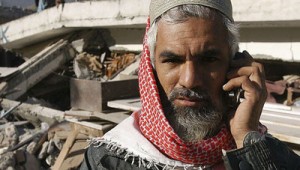Sunday Times 2
View on Poverty: Turning mobiles into emergency tools
The strongest recorded storm to ever hit land slammed into the Philippines at 195 miles per hour just over a year ago, on November 8, 2013. As a recent Guardian photo essay shows, the communities on the islands are now beginning to rebuild.

Image credit: Chris Stowers / Panos
One of the problems in the aftermath of Typhoon Haiyan was the failure of mobile phone networks. Many base stations were damaged or ran out of power, rendering the tools – which could otherwise have enabled separated families or health workers to communicate – powerless.
But there are simple and affordable tweaks that handset manufacturers could introduce to make their products more resilient and useful indisasters, according to Wladimir Alonso, a global health researcher at the US National Institutes of Health. Along with colleagues, he wrote an article on this subject earlier this year. Alonso says that implementing at least some of the changes he and his coauthors recommend could save lives when another Haiyan hits.
When I spoke to Alonso this week, he told me he was “optimistic” that one recommendation – making phones more robust – was starting to catch on. He says that some high-end handsets are now waterproof. “This is a good thing, as excessive water is a source of potential damage in many disasters,” he says.
“In general, people take their routine world for granted, with infrastructure in place and electricity, water, communication running fine. So people’s choices when purchasing a handset don’t usually take into account a world where everything can literally fall apart,” Alonso says.
“But catastrophes can strike at any time, and how mobiles are built and prepared can make a huge difference in those unthinkable situations.”
The article, published in Earth Perspectives, includes other tweaks that could make phones more useful in disaster situations. One is to reintroduce the radio receivers they used to have. These are cheap to add, and would mean survivors could access news and information broadcasts even if local mobile masts were damaged.
Another idea is to incorporate alternative means of communication that can be used when mobile operators’ networks are knocked out. In fact, the technology already exists to allow the creation of ad hoc networks by which each mobile phone in range functions as a relay point for other phones, Alonos says. The authors also suggest that manufacturers incorporate a ‘distress mode’, which, once activated, would put the phone into an energy-saving state and emit signals – flashes, sounds and radio pulses – to help rescuers locate its owner.
But the priority, says Alonso, should be boosting handsets’ ability to run for long periods of time without being connected to the mains.
“I find it really frightening, the idea that someone trapped under rubble, lost or drifting away after a tsunami cannot use this wonderful communication device only because it has run out of battery,” he says.
The article points out that the technological means to change this is already available, for instance through in-built solar cells or by dedicating a bit more space for more powerful batteries. Alonso points out that focusing on making phones more robust and autonomous wouldn’t necessarily make them less desirable to the average consumer.
“In fact, many features that can be life-saving in collective emergencies are also useful in daily situations – is your phone running out of battery right now?”
His paper also mentions a study that found that battery life was a greater influence on which phone Bangledeshi students chose to buy than the presence of a camera or a colour display.
Courtesy scidev.net

